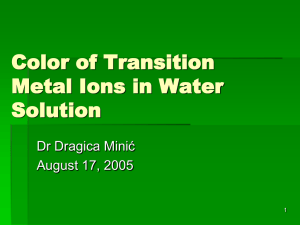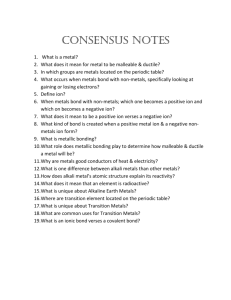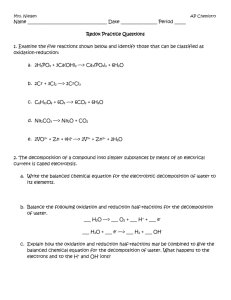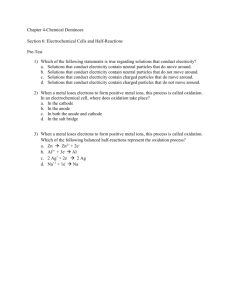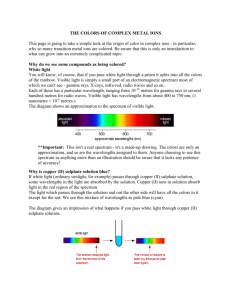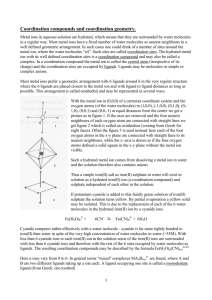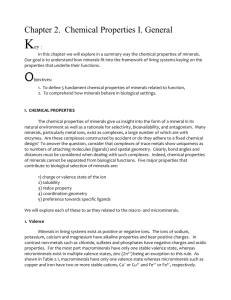Properties of the transition metals
advertisement
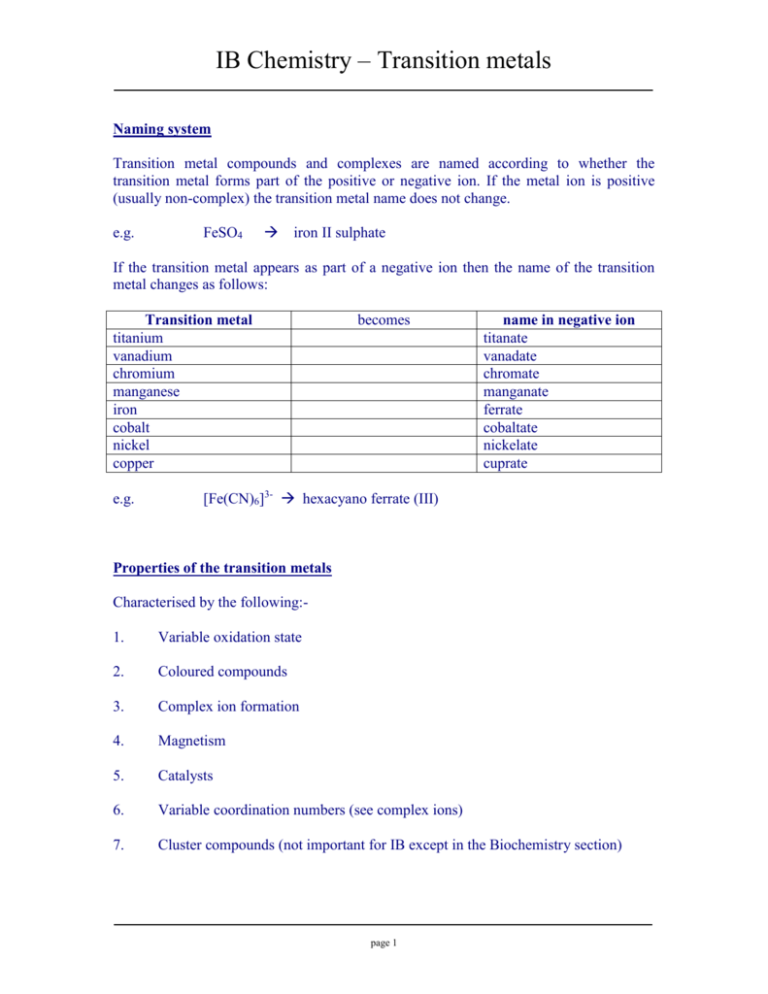
IB Chemistry – Transition metals Naming system Transition metal compounds and complexes are named according to whether the transition metal forms part of the positive or negative ion. If the metal ion is positive (usually non-complex) the transition metal name does not change. e.g. FeSO4 iron II sulphate If the transition metal appears as part of a negative ion then the name of the transition metal changes as follows: Transition metal titanium vanadium chromium manganese iron cobalt nickel copper e.g. becomes name in negative ion titanate vanadate chromate manganate ferrate cobaltate nickelate cuprate [Fe(CN)6]3- hexacyano ferrate (III) Properties of the transition metals Characterised by the following:1. Variable oxidation state 2. Coloured compounds 3. Complex ion formation 4. Magnetism 5. Catalysts 6. Variable coordination numbers (see complex ions) 7. Cluster compounds (not important for IB except in the Biochemistry section) page 1 IB Chemistry – Transition metals Variable oxidation state We must learn a few of the common oxidation states Iron II and III Manganese II, IV and VII Chromium II, III and VI Copper I and II 1. Give examples of compounds containing each of the oxidation states above (name and formula) Coloured complexes The transition metals are normally colourless if the ion is not surrounded by ligands. If it is, this creates a crystal field (region of space in which electrostatic forces create an electrical field) in which the d orbitals have unequal energy and because of this transitions can occur between them. These transitions require energy provided by light from the visible portion of the electromagnetic spectrum (this has the correct amount of energy). Hence the transition metal ions absorb part of the visible spectrum and we see only those parts of the spectrum which are allowed to pass through. Example: copper II salts usually appear blue because they absorb light from the red part of the visible spectrum. 2 For each of the examples of oxidation states in question 1 state the colour of the compound you have chosen. page 2 IB Chemistry – Transition metals The colour depends on the difference in energy between the non-degenerate “d” orbitals and this difference is created by the crystal field. This, in turn, also depends on the nature of the ligand surrounding the transition metal ion as this affects both the splitting and the geometry of the complex ion. Example: Copper II sulphate Blue (here the Cu2+ ion is surrounded by six water molecules as ligands) Copper II chloride Green (here the Cu2+ ion is surrounded by four Cl- ions as ligands) 3. Find 5 (five) more examples from the literature of changing ligand affecting the colour of the transition metal ion (there must be no change in oxidation state) Give the conditions required for each of the examples chosen and state how you would carry out the change in the lab. Complex ion formation The transition metal ions have partially filled ‘d’ orbitals which can accept electron pairs by dative coordinate bonding. These form complex ions which may be positive or negative depending on the ligands attached. The shape of the complex ions depends on the ligands, the oxidation state and type of transition metal involved. Nomenclature: The transition metal retains its name when it is involved in a positive ion but changes it in a negative ion to end with “-ate”. Example: [Fe(H2O)6]2+ Hexa aqua iron II [Fe(CN)6]4- Hexa cyano ferrate II page 3 IB Chemistry – Transition metals Common shapes 6 ligands 4 ligands 2 ligands octahedral tetrahedral or square planar linear 4. Draw and name 2 examples of each of the three geometries of complex above. Magnetism This should not be confused with ferromagnetism, which is a very strong effect created when many magnetic atoms group together into domains increasing the magnetic behavior. This only happens in the three metals iron, cobalt and nickel of which iron is the main protagonist. The magnetism described here is paramagnetism which occurs when an atom or iron has unpaired electrons. These unpaired electrons give the atom a magnetic field which can be affected by an external magnetic field and hence easily detected. To decide the number of unpaired electrons is not as straightforward as it would appear to be from a consideration of the d orbitals as these are usually non-degenerate having been “split” by the crystal field. In fact the reverse is true in that we usually arrive at the arrangement of “d” orbitals by a consideration of the magnetic properties. Example: Iron 2+ has the configuration 1s2 2s2 2p6 3s2 3p6 4s0 3d6 This would suggest four unpaired electrons in the five d orbitals, however in an octahedral field the “d” orbitals are split three and two with the dxy dxz dyz havin a lower energy than the other two. page 4 IB Chemistry – Transition metals The electrons fill up these orbitals first and so the compound are not magnetic (diamagnetism) Summary: the magnetic properties depend on the geometry of the complex ion and the ligand strength, as well as the total number of electrons in the d orbitals. 5. Suggest, with reasons, the likely magnetic properties of the following ions. Ñame them. a) [Fe(H2O)6]2+ b) [Fe(CN)6]3- c) [Fe(CN)6]4- d) [CoCl4]2- e) [Mn(NH3)6]2+ page 5 IB Chemistry – Transition metals Catalytic properties 6. Find examples of the use of each of the period 4 transition metals as catalysts. Note whether they are used as homogeneous or heterogeneous catalysts and show the industrial process envolved. page 6

